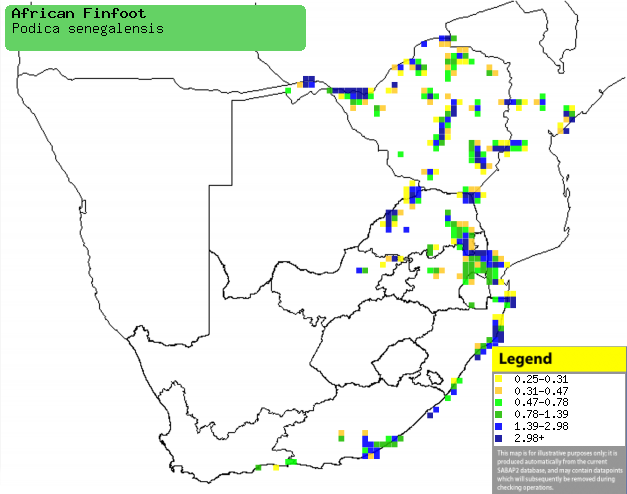|
Podica senegalensis (African
finfoot)
Watertrapper [Afrikaans]; Watertrapper [Dutch];
Grébifoulque d'Afrique [French]; Afrikanische binsenralle [German];
Pés-de-barbatanas [Portuguese]
Life
> Eukaryotes >
Opisthokonta
> Metazoa (animals) >
Bilateria >
Deuterostomia > Chordata >
Craniata > Vertebrata (vertebrates) > Gnathostomata (jawed
vertebrates) > Teleostomi (teleost fish) > Osteichthyes (bony fish) > Class:
Sarcopterygii (lobe-finned
fish) > Stegocephalia (terrestrial
vertebrates) > Tetrapoda
(four-legged vertebrates) > Reptiliomorpha > Amniota >
Reptilia (reptiles) >
Romeriida > Diapsida > Archosauromorpha > Archosauria >
Dinosauria
(dinosaurs) > Saurischia > Theropoda (bipedal predatory dinosaurs) >
Coelurosauria > Maniraptora > Aves
(birds) > Order: Gruiformes >
Family: Heliornithidae
Distribution and habitat
Occurs across much of sub-Saharan Africa, from Senegal to
western Ethiopia south through the DRC and Angola to southern Africa. Within
southern Africa it occurs in the Caprivi Strip (Namibia), Zimbabwe, central Mozambique,
north-eastern and southern South Africa and Swaziland, generally preferring
quiet wooded watercourses bordered by dense riparian vegetation, largely
avoiding fast-flowing and stagnant rivers. It is a rarely seen bird because of
its habits and habitat.
|
 |
|
Distribution of African finfoot in southern
Africa, based on statistical smoothing of the records from first SA Bird
Atlas Project (©
Animal Demography unit, University of
Cape Town; smoothing by Birgit Erni and Francesca Little). Colours range
from dark blue (most common) through to yellow (least common).
See here for the latest distribution
from the SABAP2. |
Movements and migrations
Mainly sedentary, although it may move to more
permanent wetlands in drought years.
Food
Eats mainly insects, supplemented with other invertebrates
and fish, doing most of its foraging beneath overhanging vegetation along the
river shore, plucking prey from the vegetation and water surface. The following food items have been recorded
in its diet:
- Invertebrates
- Vertebrates
Breeding
- Monogamous solitary nester, defending a territory which can vary in width
from a few hundred metres to a few kilometres.
- The nest (see image below) is a messy, deep bowl of reeds, coarse
grass, thin twigs and rush leaves, typically placed on a branch or branches
above water, or in flood debris or reeds.
- Egg-laying season is from August-April, peaking from September-March.
- It lays 1-3 eggs, which are incubated solely by the female for at least
three weeks.
- The chicks are initially brooded by their parents, leaving the nest a
few days after hatching.
Threats
Not threatened globally but Vulnerable in South
Africa and Swaziland, as it is threatened by the clearing of the riverine
vegetation it is dependent on.
References
-
Hockey PAR, Dean WRJ and Ryan PG 2005. Roberts
- Birds of southern Africa, VIIth ed. The Trustees of the John Voelcker
Bird Book Fund, Cape Town.
|
